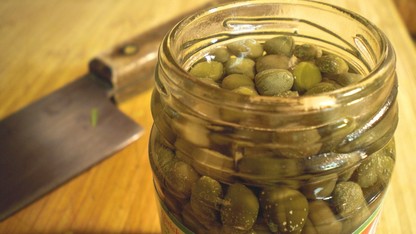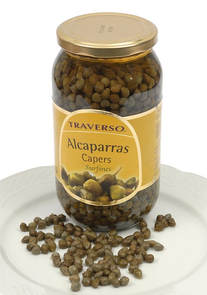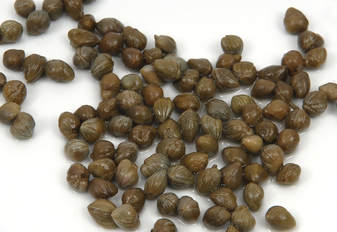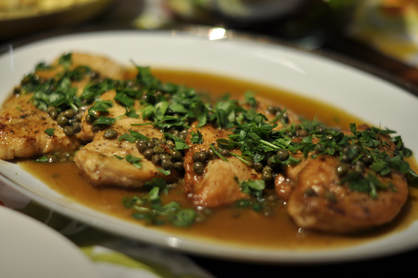So let's get fancy(ish) and look a little more into what capers are and how you can make them shine in your kitchen.
I'm not going to spend much time giving you the history of capers since, well, there are dozens of sites out there who have done way, way more research out there (Check out some of those here, here, and here). So, instead, here's the CliffsNotes version. Capers are the unopened flower buds of the Capparis spinosa plant, and apart from being fun to say, you can now also pull out that piece of trivia at your next party. Anywho...these little flower buds are picked, salted or brined, and then packed in small jars where you will usually find them next to the olives and pickles in your local grocery store. Also, while capers have a small of a reputation of being a bit of a luxury food (see: expensive), at my local grocery store, a regular 3.5oz jar costs about $2.79. You typically use capers only as a garnish or accent, so a jar can last quite a while and multiple dishes. Of course, if you go super fancy and get the imported, salt packed capers made by Italian Nuns from the foothills of Sicily, then yeah they can cost more, but you do you.
So what do they taste like? People have come up with a few descriptions from what I've seen from across the internet - peppery, mustard-like, and olive-y to name a few, but in my experience, capers taste most heavily of a lemony-olive with a touch of black pepper. So that may not be helpful, but if you've ever had green olives before, that will be the main thing you notice and the citrus second. It's also very salty as is the brine it comes in. Most of the time you will use only the capers themselves, but sometimes you may be asked to use some of the brine as well.
One last quick note, most capers you will probably find in the grocery store will be the smallest variety called non-pareil. That is perfectly fine and it's what most dishes will probably call for anyways.
Well of course, and they're delicious if used in the appropriate amount. Like I mentioned briefly earlier, capers feature most heavily in Mediterranean and Italian cuisine, especially in Sicily (Looking at you, New Yorkers and New Jerseyites). Some classic dishes they feature in are Piccatas, Pasta Puttanesca, and even in some more surprising places like Tartar sauce.
Use it modestly in places where you would want to add some salty, briney kick. Capers typically plays well with lemon, so many dishes which feature lemon also include capers to provide another layer of flavour and zest or contrast an otherwise richer dish - think capers on a bagel with lox and cream cheese.
Mayo based salads like potato salad or egg salad are an unexpected place to add some capers to bring some punch and flavour to an otherwise one-noted dish. The next time you make a large batch, try taking a tablespoon of drained capers, roughly chop them, and mix them in with some fresh chopped parsley before serving. The salt and light lemon flavour can help cut the richness of the mayo.
Seafood dishes are another area where capers can shine. Fattier fishes, like salmon and swordfish can play well with capers. Next time you cook a salmon filet, try a simple sauce made with melted butter, capers, and a squeeze of lemon like this one here.
These are just some examples of where capers can lend a helping hand to dress up a dish. Play around as you get accustomed to the flavour on what else you can do - including adding them to salad dressings, pasta dishes, and more.
Wrap-Up and a Recipe
So I'm not going to leave you without a recipe, so here's a classic which I actually made very recently - Chicken Piccata with Mashed Potatoes. Yes, serving it with mashed potato may seem weird instead of pasta at first, but try it out. The mash really takes in the lemony sauce and serves as a great canvas for all the flavours at play.
Serves 4
Ingredients:
For the Piccata:
- 2 Large Chicken Breasts - About 1.5 lbs total
- 3 Lemons, juiced
- 1 Tablespoon Capers with Brine
- 1 Cup Chicken Broth
- Two Tablespoons Butter
- 1/3 Cup Parsley, Chopped
- Flour
- Salt and Pepper
- 2 tablespoons butter
- Olive Oil and Butter to Pan Fry
For the Mashed Potatoes:
- 4-5 Medium Russet Potatoes, peeled and cut into large chunks
- 2 Tablespoons Butter
- 1/4 Light Mayonnaise (Or Regular - You do You)
- Salt and Pepper
Directions:
- Prepare the Potatoes - Boil a large pot of heavily salted water and add the potatoes. Boil until fork tender. Drain and set potatoes back in the pot until ready.
- Slice the two Chicken breasts in half horizontally, so you get four thin breast-halves. (Think about cutting it so it opens like a book)
- Season both sides of the four pieces of chicken with salt and pepper
- In a bowl, add about 1 cup of flour, 1 tsp of salt, and 1 tsp of pepper and mix
- One piece at a time, add the chicken and coat with the flour, shaking off the excess
- In a large pan, heat 2 tablespoons of olive oil and 1 Tablespoon of butter over medium-high heat until butter is melted and sizzles in the olive oil (about 2 minutes)
- Add two flour coated chicken breast pieces at a time and cook about 3-4 minutes per side until browned on both sides. Transfer to a plate when done.
- Add 1 additional tablespoon of olive oil and repeat pan frying with the remaining two pieces of chicken
- After removing chicken, reduce the heat to medium and add the chicken broth. Scrape the bottom of the pan to pick up any browning. Once bubbling, add lemon juice, 2 tablespoons of butter, and capers and return to a boil over medium heat.
- Add all four pieces of chicken back in the pan and reduce heat to medium-low. Simmer chicken in the sauce for 3-4 minutes
- In the meantime, add mayonnaise and butter to the boiled potatoes and mash until smooth. Season with salt and pepper to taste.
- Serve the mashed potatoes on four plates. Remove the chicken breasts from the sauce and serve on top of the mashed potatoes
- In the chicken piccata pan, add fresh parsley to the sauce and stir until just cooked and sauce is thickened. Serve over chicken and mashed potatoes.
Cheers!




